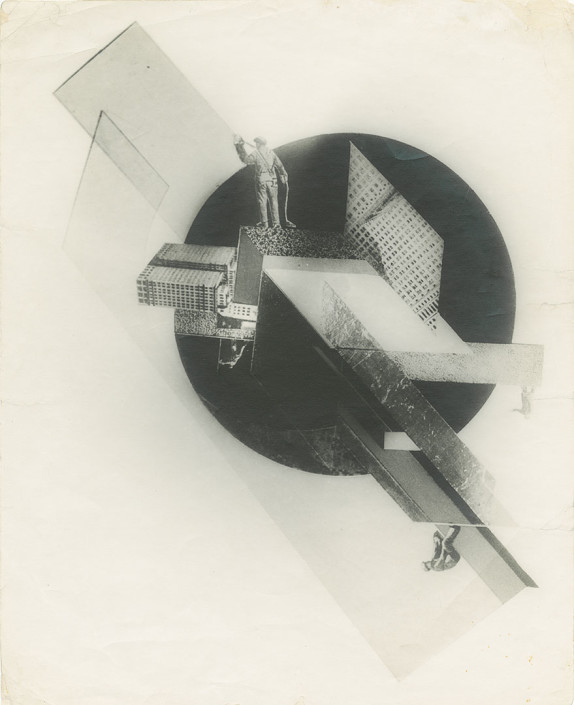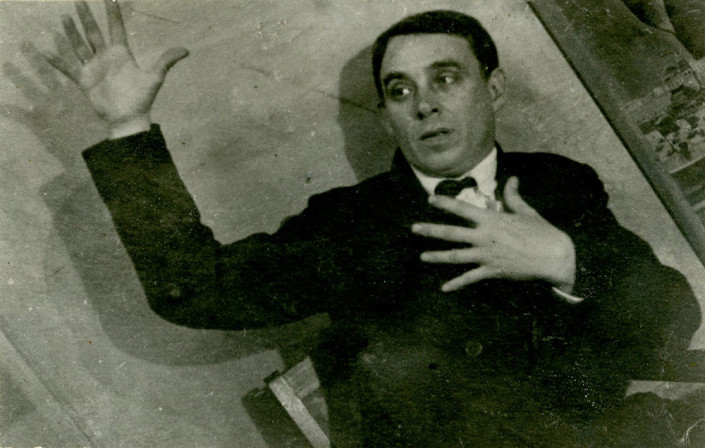GUSTAV KLUTSIS
GUSTAV KLUTSIS (1895-1938)
Following two years of art school in his native Latvia, Gustav Klutsis (1895 – 1938) was drafted into the Russian Army, and pariticipated in the 1917 oftherthrow of the tsar. In 1919, Klutsis resumed his art schooling in Moscow in the studios of Konstantin Korovin and Kazimir Malevich. Acclaimed for his spatial constructions, as well for his designs of practical structures like kiosks, tribunes, and radio-orators, Klutsis became a professor of color theory at the construcitivist school VKhUTEMAS (Higher State Artistic-Technical Workshops) in 1924. In addition to being an accomplished constuctivist, by the early 1920s, Klutsis had become a pioneering developer of photomontage. Klutsis applied photomontage to innovative designs for posters, magazines, and books throughout the 1920s and 1930s, and the technique was swiftly adopted by others members of the Soviet avant-garde. In addition to being one of photomontage’s leading practitioners, he also participated in debates on the subject, published essays on his theories, and contributed to major exhibitions, including the Internationale Presse-Ausstellung (Pressa) 1928 , and Film and Foto, 1929. Alongside the works of Aleksandr Rodchenko, Varvara Stepanova, El Lissitzky, and Sergei Senkin, Klutsis’s work stands one of the strongest examples of the postabstract Soviet avant-garde.
Although a devoted member of the Communist Party, Klutsis was arrested and detained in 1938, shortly after returning from the Paris World’s Fair, where he designed numerous exhibitions and installed a photomontage frieze that he created for the Soviet pavilion. He was executed three weeks after his arrest.
GUSTAV KLUTSIS (1895-1938)
Nach zweijährigem Kunststudium in seiner Heimat Lettland wurde Gustav Klutsis (1895 – 1938) in die russische Armee eingezogen und war 1917 am Sturz des Zaren beteiligt. Im Jahr 1919 nahm Klutsis das Kunststudium in Moskau in den Ateliers von Konstantin Korovin und Kazimir Malevich wieder auf. Hoch gelobt für seine räumlichen Konstruktionen sowie für eher praktische Entwürfe von Kiosken, Bühnenkonstruktionen und Lautsprechertribünen, wurde Klutsis im Jahr 1924 zum Professor für Farblehre an die konstruktivistische Kunsthochschule VKhUTEMAS (Höhere künstlerisch-technische Werkstätten) berufen. Zusätzlich zu seinen Leistungen auf dem Gebiet des Konstruktivismus avancierte Klutsis bereits in den frühen 1920er Jahren zu einem Pionier der Fotomontage. Klutsis verwendete diese Technik während der 1920er und 1930er Jahre durchgängig in seinen innovativen Designs für Plakate, Zeitschriften und Bücher, und seine Technik wurde rasch von anderen Vertretern der sowjetischen Avantgarde übernommen. Als führender Vertreter auf seinem Gebiet nahm er an Diskussionen zum Thema Fotomontage teil, veröffentlichte Essays über seine Theorien und wurde zu wichtigen Ausstellungen eingeladen, wie unter anderen die Internationale Presse-Ausstellung (Pressa) 1928, sowie Film and Foto, 1929.
Obwohl er ein engagiertes Mitglied der kommunistischen Partei war, wurde Klutsis im Jahr 1938 verhaftet und inhaftiert – unmittelbar nach seiner Rückkehr von der Pariser Weltausstellung, wo er verschiedene Ausstellungen konzipiert und ein von ihm für den sowjetischen Pavillon geschaffenes Fotomontage-Fries installiert hatte. Drei Wochen nach seiner Verhaftung wurde Gustav Klutsis hingerichtet.










